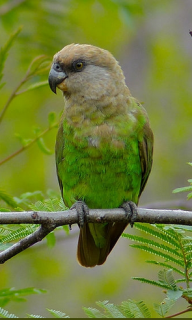Brown-headed Parrot |
|
|
Also known as: Concealed-yellow Parrot
Photos
View in GalleryDid You Know?
'Cryptoxanthus' means 'concealed yellow' which in the case of the Brown-headed Parrot refers to the yellow on its underwing coverts.Academic Research
Related publications: Poicephalus cryptoxanthusSpecies Profile
Genus: Poicephalus | Species: cryptoxanthus
Size:
22cm (8.6 in)
Weight:
120-156g (4.2-5.4 oz)
Subspecies including nominate:
two: P.c. Crytoxanthus, P.c. tanganyikae
Colour Adult:
P.c. cryptoxanthus: Both adults small, mainly green parrots with grey/brown head; bright yellow underwings. Blue/grey upper mandible, tan lower. Bare cere and eye ring dark brown/grey. Eye yellow.
P.c. tanganyikae: As in cryptoxanthus but paler; more green and less brown. Mantle greener and underparts brighter.
Colour Juvenile:
As in adult but duller with brown eye.
Call:
Flight call loud strident notes rising in pitch with each following note. Also high pitched staccato notes. Feeding accompanied by soft chattering.
Listen NowVideo Links:
Video 1More Information:
Content Sources:
CITES
BirdLife International
Cornell Lab of Ornithology/Birds of the World
A Guide to Parrots of the World, Juniper and Parr, 1998
ML Media Collection Catalogue 135979, Brown-headed Parrot Poicephalus cryptoxanthus, Macaulay, Linda, Tanzania, Oct. 6 2002, Cornell Lab of Ornithology. Site
Parrots of the World, Forshaw and Cooper, 1989.
Parrots of the World, Forshaw, 2006.
Parrots in Aviculture, Low, 1992.
Parrots: Their Care and Breeding, Low, 1986.
Photos
View in GalleryDid You Know?
'Cryptoxanthus' means 'concealed yellow' which in the case of the Brown-headed Parrot refers to the yellow on its underwing coverts.Academic Research
Related publications: Poicephalus cryptoxanthusSpecies Care
Captive Status:
Uncommon
Longevity:
20-25 yrs
Housing:
Walk-in aviariy, minimum length 2.1m (7 ft), or indoor cage minimum length 1.8m (6 ft).
Diet:
Cooked beans and pulses, boiled corn; sunflower, dry, soaked or sprouted; fruit, especially apple, orange, banana, rearing food made from: hard-boiled egg, wholegrain bread, and carrot, all ground to crumbly consistency; fresh vegetables, complete pellet.
Enrichment:
Bathing; foot toys, destructible (non-toxic) toys, non-destructible (non-toxic plastic) toys, food-finder toys, preening toys, different texture and size hanging perch toys, fir, pine, elder or willow branches, push-and-pull toys (sliding up and down), vegetable tanned leather toys.
Nest Box Size:
Vertical box, 12" x 12" x 24" (30.5cm x 30.5cm x 61cm).
Clutch Size:
2 to 4
Incubation Time:
26 days
Fledging Age:
11 weeks
Hatch Weight:
5.5-6g (0.2 oz)
Peak Weight:
Not recorded.
Weaning Weight:
About 125-150g (4.3-5.25 oz)
Photos
View in GalleryDid You Know?
'Cryptoxanthus' means 'concealed yellow' which in the case of the Brown-headed Parrot refers to the yellow on its underwing coverts.Academic Research
Related publications: Poicephalus cryptoxanthusSpecies Wild Status
World Population:
Unknown, stable.
IUCN Red List Status:
Least Concern
CITES Listing:
Appendix II
Threat Summary:
Not globally threatened. Locally common, E Transvaal, especially in Kruger National Park; decline in other areas. Becoming vulnerable to habitat destruction; trapping for wild bird trade becoming a concern in Mozambique.
Range:
P.c. cryptoxanthus: E Kwazulu, E Swaziland and E Transvaal, NE Republic of South Africa, to S Mozambique and SE Zimbabwe.
P.c. tanganyikae: Mozambique, north from Save River and S Malawi to E Tanzania including Zanzibar and Pemba Islands and coastal Kenya.
Habitat:
Occurs in almost any woodland and riparian forest within the forest savanna and dry woodlands. Also coconut plantations. Below 1200m (3936 ft).
Wild Diet:
Diet includes seeds of Erythrina and Adansonia; nuts; fruits, especially Ficus figs, Pseudocadia zambesica and berries of cultivated cassava; pods of Acacia and Albizia gummifera, nectar of Aloe marlothii and Kigelia pinnata; coconut flowers and green tree shoots. Also takes millet and maize crops.
Ecology and Behaviour:
Slow foraging, drinks around midday. Nests in tree cavity. Gregarious, recorded in flocks of up to 50 birds.
Clutch and Egg Size:
2 to 4, rounded, 27.0 x 23.0 mm (1 x 0.9 in)
Breeding Season:
April-October S Africa; May in Malawi; July and September in Mozambique; April, June and July in E Africa, and probably September–October on Zanzibar and Pemba. Nest is in unlined tree cavity.
Photos
View in GalleryDid You Know?
'Cryptoxanthus' means 'concealed yellow' which in the case of the Brown-headed Parrot refers to the yellow on its underwing coverts.Academic Research
Related publications: Poicephalus cryptoxanthusMembers Only Resources
Please log-in now to find more research, resources and tools.
Not a Member?
Find more great information:
Gain exclusive access to 600+ pages of additional research, seminars and podcasts, specialists to ask your toughest questions, and dozens of other fun resources - when you become a WPT member.
Join Today >>

































